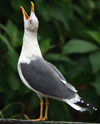 Atlantic Yellow-legged Gull (atlantis)
Atlantic Yellow-legged Gull (atlantis)
(last update: October 12, 2011)
Atlantic YLG adult January
data from: Malling Olsen, K. & Larsson, H. 2004 Gulls of Europe, Asia and North America. London: Christopher Helm.
We start with general description & adult plumage:
L. m. atlantis Atlantic Gull (Azores, probably also Madeira, Canary Isles, Atlantic coastline between N Iberian and Morocco). Sedentary, with some spread to NW Africa and sub-Saharan W Coast in winter; possibly straggler to N America (Wilds & Czaplak 1994). May require specific status, as adult and first-year plumages differ from other subspecies, being closer to Lesser Black-backed Gull race graellsii, of which it is sometimes regarded as a sedentary form (Dwight 1925). The darkest taxon. The darkest, most extreme birds with densest head-streaking in winter plumage found in the Azores; birds from Madeira and Canary Islands more like michahellis and often regarded as michahellis. While we fully accept that only Azores birds should be regarded as true atlantis, we include here information from Madeira/ Canary Islands, preferring to keep these birds under atlantis until more is known about differences between the populations from different areas.
Atlantic Gull is on average smaller and more compact than nominate michahellis. Head squarer, forehead often flat, and bill stockier with generally longer gonys-angle. Wings and legs relatively shorter. Nostril, compared to michahellis, generally deeper at distal edge (c. 2mm) and shorter (9-11mm). Bill length : bill depth at gonys 2.6-3.0. Long gape-line sometimes down curved.
Adult In the Azores has dark slate upperparts similar to Lesser Black-backed Gull race graellsii (Kodak Grey Scale 7-9); more varying in Madeira, where some as nominate michahellis. Certain Canary Island adults as dark as Azores birds. Upperparts sometimes with faint olive tinge. P9-P10 black, P10 with 32-45mm white mirror, rarely covering one or both webs to form white tip (Madeira), White mirror on P9 in 10% of Canary Island / Madeiran populations, <2% in the Azores (pers. obs). Division between grey and black on P6-P7 sharp, on inner web diffuse. P6 with 30-50 mm black sub-terminal bar, P5 with 20 mm black sub-terminal bar and narrow white tongues restricted to inner web. On P5-P6 often most black on outer web, as in most Caspian Gull nominate cachinnans. P4 grey, in 75% with dark sub-terminal spot, most frequent on outer web where max 22 mm. P3 in 10% with dark markings, max 9 mm on outer web. Wing-tip black on both surfaces. In winter (Aug – Nov/Dec), head more strongly patterned than in michahellis, similar to Herring and Lesser Black-back, but
streaking even denser behind eye and below gape but fainter on hindneck. Azores (and a few Madeiran) birds have even stronger head-spotting and look dark-hooded at distance (pers. obs.; versus Gruber 1995), hind-neck sometimes unstreaked. Head is mainly white with narrow dark streaks around eye and well-scattered brown spots on crown, hindneck and ear-coverts (Madeira and Canary Islands populations). Bill in winter dull yellow with orange gonys-spot and sometimes dark sub-terminal bar. In summer similar to michahellis, but lighter orange-yellow. Iris pale creamy to pale yellow (as in Herring), thus paler than in michahellis, but sometimes dark-freckled. Legs yellow; a few cases of pink-legged birds from the Azores known (Dubois 2001).
Continue with juvenile plumage.
 Atlantic YLG (atlantis) adult,
January 30 2008, Azores Islands. Picture: Dominic Mitchell. White head.
Atlantic YLG (atlantis) adult,
January 30 2008, Azores Islands. Picture: Dominic Mitchell. White head. Atlantic YLG (atlantis) adult,
January 29 2008, Azores Islands. Picture: Dominic Mitchell. White head. Saturated bare parts.
Atlantic YLG (atlantis) adult,
January 29 2008, Azores Islands. Picture: Dominic Mitchell. White head. Saturated bare parts. Atlantic YLG (atlantis) adult,
January 30 2008, Azores Islands. Picture: Dominic Mitchell. White head. P5 full sub-terminal band; P4 black spot on outer-web. No mirror on P9.
Atlantic YLG (atlantis) adult,
January 30 2008, Azores Islands. Picture: Dominic Mitchell. White head. P5 full sub-terminal band; P4 black spot on outer-web. No mirror on P9. Atlantic YLG (atlantis) adult,
January 30 2008, Azores Islands. Picture: Dominic Mitchell. White head. Note red on upper mandible.
Atlantic YLG (atlantis) adult,
January 30 2008, Azores Islands. Picture: Dominic Mitchell. White head. Note red on upper mandible. Atlantic YLG (atlantis) adult,
January 29 2008, Azores Islands. Picture: Dominic Mitchell. Fine streaking on head, especially crown. Saturated bare parts. Full sub-terminal band on P10.
Atlantic YLG (atlantis) adult,
January 29 2008, Azores Islands. Picture: Dominic Mitchell. Fine streaking on head, especially crown. Saturated bare parts. Full sub-terminal band on P10. Atlantic YLG (atlantis) adult,
January 03 2010, Las Palmas, Gran Canaria - Canary Islands. Picture: Asier Aldalur. Adult bird, with full sub-terminal band on P10 (common pattern in atlantis).
Atlantic YLG (atlantis) adult,
January 03 2010, Las Palmas, Gran Canaria - Canary Islands. Picture: Asier Aldalur. Adult bird, with full sub-terminal band on P10 (common pattern in atlantis).